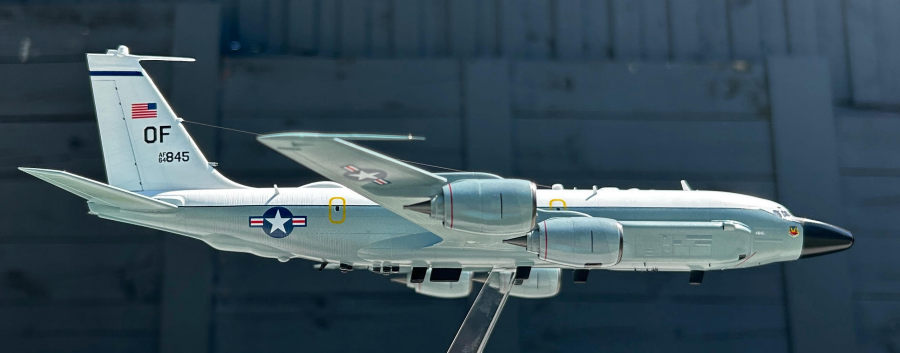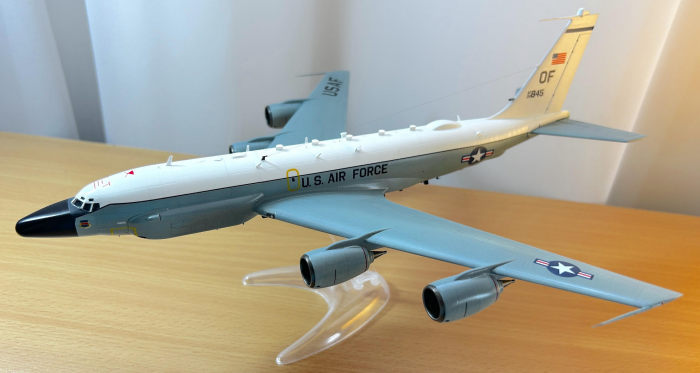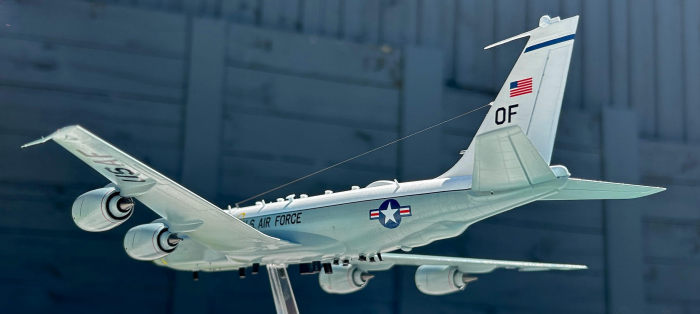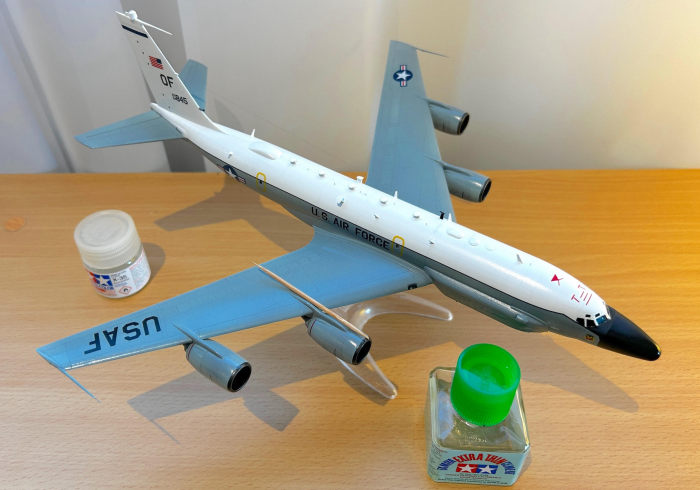
| KIT #: | 349 |
| PRICE: | AU$50.00 |
| DECALS: | One option |
| REVIEWER: | Marcello Rosa |
| NOTES: |

| HISTORY |
 Until
recently, I thought that the C-135 family of planes came from modified Boeing
707s, but doing the research for building this model educated me otherwise. In
truth, both the military and the civilian plane lineages were derived from the
prototype Boeing 367-80 (the “Dash 8”) – thus, more a case of parallel evolution
than direct ancestry. Despite the narrower and shorter fuselage in comparison
with the Boeing 707, the family resemblance is undeniable. These elegant planes
have been gracing our skies since the 1950’s, and continue to serve the USAF and
its allies to this date – including the subject of this build, the electronic
reconnaissance RC-135 version.
Until
recently, I thought that the C-135 family of planes came from modified Boeing
707s, but doing the research for building this model educated me otherwise. In
truth, both the military and the civilian plane lineages were derived from the
prototype Boeing 367-80 (the “Dash 8”) – thus, more a case of parallel evolution
than direct ancestry. Despite the narrower and shorter fuselage in comparison
with the Boeing 707, the family resemblance is undeniable. These elegant planes
have been gracing our skies since the 1950’s, and continue to serve the USAF and
its allies to this date – including the subject of this build, the electronic
reconnaissance RC-135 version.
RC-135s have been involved in nearly every conflict involving the United States, including Vietnam, the Balkans, both Desert Storm and Desert Shield. Even today (2023) the current version optimised for signals intelligence (RC-135V/W; letter designations just reflect different engine configurations, at least according to open sources) continues to keep an eye (ear?) on what is happening in Ukraine and the Middle East. The RC-135V/Ws (program designation Rivet Joint) differ from other members of the C-135 family most obviously by having large antenna fairings on the “cheeks”, and by the myriad of antennas spread everywhere. Even these additions fail to spoil the good looks.
| THE KIT |
 Ukranian
company Roden has found a place in my heart as the go-to provider of kits of
interesting subjects that remain under-represented by the major manufacturers.
But you don't decide to start on a Roden because you want perfectly fitting
parts, and refined engineering. You do it because this manufacturer provides
reasonably accurate, reasonably priced kits of unique subjects.
Ukranian
company Roden has found a place in my heart as the go-to provider of kits of
interesting subjects that remain under-represented by the major manufacturers.
But you don't decide to start on a Roden because you want perfectly fitting
parts, and refined engineering. You do it because this manufacturer provides
reasonably accurate, reasonably priced kits of unique subjects.
Having said that, the overall quality was better than what I found in the slightly older B-36D (if you are interested check here. For example, in this Rivet Joint kit joining the wings and horizontal stabilisers to the fuselage required only a tiny bit of filler and minimal sanding, and the “cheek” fairings fitted perfectly. I hope that this indicates that Roden is on a path to improvement. It is also appropriate to mention that this kit provides absolutely no parts for anything inside. I found this acceptable because the cockpit windows are so small in 1/144 scale that nothing can be seen anyway.
Unfortunately, all this positivity ends when it comes to the decals, which continue to be the Achilles’ heel of Roden kits. They range from barely usable to absolutely terrible. Decals representing the yellow outlines of the doors and electronics bay were particularly bad in terms of transparency and uniformity.
| CONSTRUCTION |
The fitting between parts was generally good. The only major hassle was joining the engines to the wings, where a very visible gap along the upper surface of the braces required endless cycles of filling and sanding. I followed the instructions except for adding the assemblies representing the engine intakes and blades at the very end, to avoid having to mask these metallic parts.
Having decided to represent the plane in flight, an old Airfix stand was repurposed for this model. I also closed the wheel bays using the provided parts, which fit onto the wing and fuselage surfaces without dramas.
 As one
would expect, this build was all about the antennas. The first challenge comes
when you join the fuselage halves, because many of the antennas are moulded into
one of the sides. This creates a problem because there is a prominent seam line
that needs to be sanded. This could have been easily avoided if the antennas
were provided as separate parts, to be added after the fuselage was joined.
There is no easy solution to that one, other than getting sanding sticks and
sponges of different sizes and shapes, and trying to go around the many bumps.
As one
would expect, this build was all about the antennas. The first challenge comes
when you join the fuselage halves, because many of the antennas are moulded into
one of the sides. This creates a problem because there is a prominent seam line
that needs to be sanded. This could have been easily avoided if the antennas
were provided as separate parts, to be added after the fuselage was joined.
There is no easy solution to that one, other than getting sanding sticks and
sponges of different sizes and shapes, and trying to go around the many bumps.
Also, surprising no one, the antennas break all the time as you turn the model around to paint, place decals, etc. There is no way around that I could find, since delaying the installation to the end would probably have meant unnatural transitions in painting. I installed most antennas just prior to priming. Towards the end, the constant fixing of broken bits made me feel like I was doing 3 steps forward, 2 steps back, all the time. At least this gave me plenty of opportunities to substitute the thick plastic antennas with more suitably sized ones, cut from spare photoetch. I also took the opportunity to add photoetch versions of several antennas that are scattered everywhere, but not represented in plastic (for example, the group of tiny antennas located on the ventral surface between the “cheeks”). The long antennas at the wing tips and top of the vertical stabiliser were slightly extended to match reference images. Also notie, contrary to what the instructions would make you think, you have to cut your own notch in the wingtips to fit the long antennas.
The biggest letdown in this kit was the fact that some of the parts representing the caps of the "mushroom" antennas were malformed. You simply cannot have a Rivet Joint without these looking good! My solution was to get some Evergreen sheet, and use an appropriately sized hole punch to create substitutes.
A final word of caution: The engine intakes come in sprues that have chunky cross-braces inside. This causes a devilish problem when you need to sand them to a smooth finish (as you do, for a metallic part). My solution was to get progressively finer sanding sponges bent into little strips, and keep them going 'round and 'round inside for a long time. Whoever in the Roden headquarters decided to leave those cross braces inside needs some talking to...
| COLORS & MARKINGS |
 This kit
comes with recessed panel lines, which appear too deep and wide relative to what
you see in photos of the real planes. This is common in 1:144 kits, so not a
problem specific to Roden; in fact, I think it is better to have them and tone
down, than not to have them. Thus, I started by sanding off the panel lines to
just leave a suggestion, before application of primer (Mr. Color light grey
1000, from a rattle can). I then pre-shaded them using a lead pencil.
This kit
comes with recessed panel lines, which appear too deep and wide relative to what
you see in photos of the real planes. This is common in 1:144 kits, so not a
problem specific to Roden; in fact, I think it is better to have them and tone
down, than not to have them. Thus, I started by sanding off the panel lines to
just leave a suggestion, before application of primer (Mr. Color light grey
1000, from a rattle can). I then pre-shaded them using a lead pencil.
I tried to find a balance between matching the reference images (which always indicate well-maintained planes with minimal weathering), and avoiding an entirely toy-like appearance. The fact that the grey surfaces in the real RC-135s are quite reflective compounded this issue. The dorsal fuselage was painted with SMS white, and the remainder with various tones of bluish and light grey. The base colour was AK 3rd generation ADC grey, which was however a bit too light and too blue in comparison with the references. Thus, I followed this base coat with successive light layers of Mr Color Greyish Blue, Mr Color RLM78 Light Blue, and Vallejo Flanker Light Grey. These were sometimes airbrushed to masked panels, to add some sense of variation due to weathering. SMS clear gloss was used both before and after the decals.
From the decals provided in the kit I used the USAF insignias, the “USAF” and "U. S. AIR FORCE” lettering, the tail markings, and the red lines above the cockpit. Other decals representing lines were too wide in comparison with my reference images, so I ended up using leftovers from other builds. This included, for example, the entire black trim separating the white and grey sections of the fuselage. Decals representing the yellow outlines of the doors and electronics bay were particularly bad in terms of transparency and uniformity, and these ended up being painted over by hand (with mixed results). I used other spare decals, sometimes cut and combined in pieces, to represent details that exist in reference images, but were not provided with the kit.
| CONCLUSIONS |
In summary, this kit gives you the basics for building a model of a great-looking, and yet unusual plane, with levels of detail appropriate for 1:144 scale. The quality is sufficient allow both novices and experienced modellers to enjoy the build, including adding more detail according to your level of experience and desire to be obsessive. Having said that, an aftermarket decal set is strongly recommended. If you would like to see more pictures of the construction process, or ask questions, please visit my modelling web site (www.marcellorosa.com) .
| REFERENCES |
https://irp.fas.org/program/collect/rivet_joint.htm
https://www.af.mil/About-Us/Fact-Sheets/Display/Article/104608/rc-135vw-rivet-joint/
https://www.airforce-technology.com/projects/boeing-rc135/?cf-view
There are lots of freely available, good quality reference photos, including at: https://commons.wikimedia.org/wiki/Category:RC-135V/W_Rivet_Joint
Marcello Rosa
16 November 2023
Copyright ModelingMadness.com. All rights reserved. No reproduction in part or in whole without express permission from the editor.
If you would like your product reviewed fairly and fairly quickly, please contact the editor or see other details in the Note to Contributors.